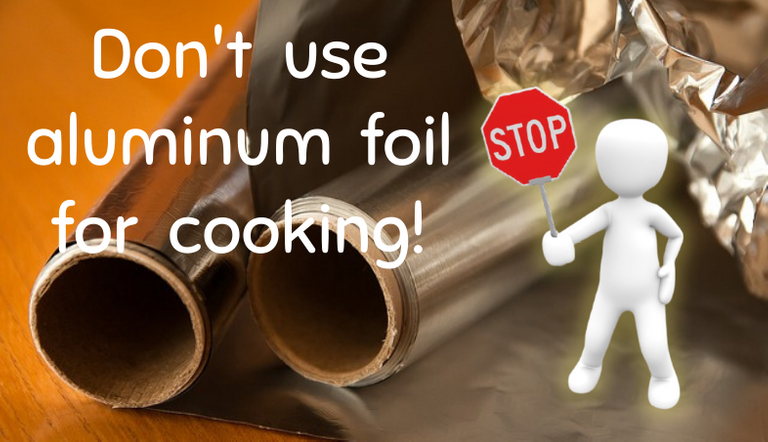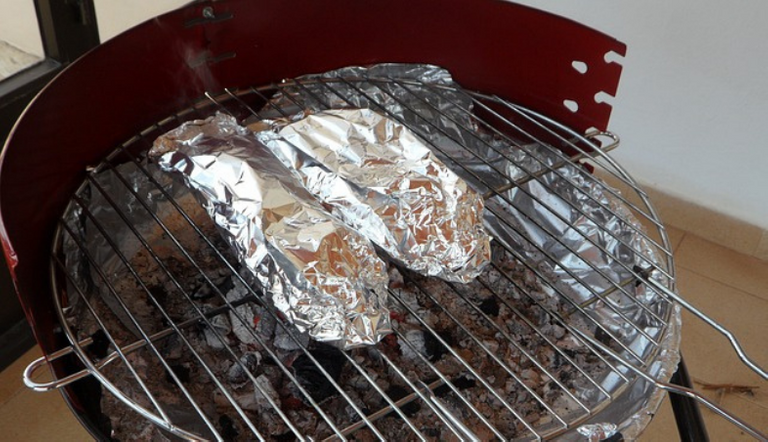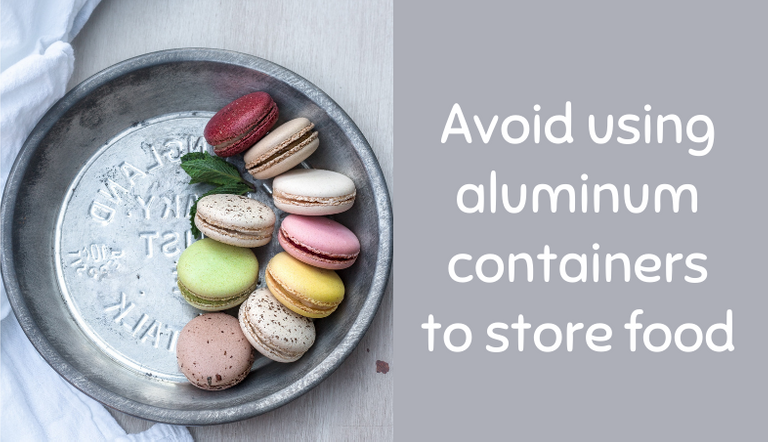Don't use aluminum foil for cooking! / ¡No uses papel de aluminio para cocinar! [ENG/ESP]
With the advances in the technological area, in these times, we enjoy many things that make our lives easier in several activities that we perform in our daily chores. The kitchen could not escape from this, where several materials have been developed to manufacture utensils, containers to store food as well as pack food, such as aluminum foil.
Con los avances del hombre en el área tecnológica, en estos tiempos disfrutamos de muchas cosas que nos facilitan la vida en varias actividades que realizamos en el quehacer diario. La cocina no podía escapar a ello donde se han desarrollado diversos materiales para fabricar utensilios, envases para almacenar comida así como para embalar alimentos como el papel de aluminio.


In the early 20th-century aluminum foil was used for wrapping sweets treats such as candies, chewing gum, and chocolates. The function of this novel wrapping was to preserve these foods from the humidity of the environment and natural light, thus preventing the deterioration of these sweets treats.
Aluminum foil has come a long way and has become a widely used complement in our kitchens. Different thickness millimeters are depending on the use we want to give it. Thus we have aluminum foil from conventional to extra-strong. However, to make it resistant and malleable when it is manufactured, magnesium is added to the aluminum to achieve this quality in this wrapping.
El papel de aluminio fue fabricado a principios del siglo XX. Los primeros alimentos en ser envueltos en él fueron golosinas como caramelos, chicles y chocolates. La función de este novedoso envoltorio era preservar a estos alimentos de la humedad del medio ambiente y de la luz natural evitando así el deterioro de las golosinas mencionadas.
Mucho es el camino que ha recorrido el papel de aluminio hasta nuestros días convirtiéndose en un complemento muy utilizado en nuestras cocinas. Hay de variados milímetros de espesor según el uso que se le quiera dar. Así tenemos papel de aluminio desde el convencional hasta el extra-fuerte. No obstante para hacerlo resistente y maleable cuando se fabrica, al aluminio se le agrega magnesio para conseguir esta cualidad en este envoltorio.



In theory, all utensils, containers for storing and wrapping food have to be safe, that is why once they are invented they have an FDA permit that guarantees their use in activities involving food. However, since 15 years ago, scientists have been studying how innocuous this material is especially not only aluminum foil, but also containers made of aluminum where food is cooked, such as biscuits, or pre-prepared food is packaged to be heated in microwaves.
The results are alarming since cooking foods wrapped in aluminum foil contaminates them with this metal. The higher the temperature (above 180ºC), the more the food interacts with the aluminum foil. When is this more serious? This occurs at the food to be cooked wrapped in aluminum foil is seasoned with salt or some seasonings that lower its pH below 4. This means that if a chicken or fish that has wine or orange juice in its maceration will have a very high probability of interacting with the aluminum foil passing this metal to the food. This transfer is also observed in alkaline foods with a pH higher than 8, this means that if we bake or grill potatoes or corn wrapped in aluminum foil, the transfer of this metal to the vegetables we will eat will occur.
En teoría todo utensilio, envase para almacenar y para envolver alimentos ha de ser inocuo por eso una vez que se inventan tienen un permiso de la FDA que garantiza su uso en actividades que involucren alimentos. Sin embargo desde hace 15 años atrás los científicos se han dado a la tarea de estudiar que tan inocuo es este material en especial no solo el papel de aluminio, también involucra envases hechos de aluminio donde se cocinan alimentos como bizcochos, o se envasan comidas pre-elaboradas para ser calentadas en microondas.
Los resultados son alarmantes ya que al cocinar los alimentos envueltos en aluminio se contaminan con este metal. Mientras más alta es la temperatura (superior a 180ºC) el alimento interactúa con el papel aluminio. ¿Cuándo esto es más grave? Cuando el alimento a cocinar envuelto en papel de aluminio es sazonado con sal o algunos aderezos que disminuyan su pH por debajo de 4. Esto quiere decir que si un pollo o pescado que tenga vino o jugo de naranja en su maceración tendrá altísimas probabilidad de interactuar con el aluminio del papel pasando este metal al alimento. Esta transferencia también se observa en alimentos alcalinos con un pH superior a 8, esto quiere decir que si horneamos o cocinamos a la parrilla papas o maíz envueltos en papel de aluminio ocurrirá transferencia de este metal hacia los vegetales que consumiremos.



The consumption of aluminum through this route occurs in small quantities, but our body does not have an efficient way to metabolize and dispose of it, therefore there is a long-term accumulation of this metal whose consequences are neurological disorders, osteomalacia (softening of the bones), and anemia, among others.
If you think that the use of aluminum foil transfers this metal to your food just by cooking with it, that is, by applying heat to it, I have bad news for you. There are recent studies that have found aluminum transfer in foods refrigerated in disposable aluminum containers or wrapped in paper, which indicates that not only by heat occurs this transfer, also influences the contact time of the food with this material.
El consumo de aluminio a través de esta vía ocurre en pequeñas cantidades, pero nuestro organismo no tiene una forma eficiente de metabolizarlo y desecharlo por lo tanto hay una acumulación a largo plazo de este metal cuyas consecuencias son afecciones neurológicas, osteomalacia (reblandecimiento de los huesos) y anemia entre otras.
Si piensas que el uso del papel de aluminio transfiere este metal hacia tus alimentos solo por cocinar con él, es decir por aplicarle calor, pues tengo una mala noticia para ti. Hay estudios recientes que han encontrado transferencia de aluminio en alimentos refrigerados en envases desechables de aluminio o envueltos en papel, lo cual indica que no solo por el calor ocurre esta transferencia, también influye el tiempo de contacto del alimento con este material.



If you want to learn more about this topic, I invite you to read the following links:
Si quieres profundizar más sobre este tema te invito a leer los siguientes enlaces:
Quantification of the Aluminum Content Leached into Foods Baked Using Aluminum Foil
Concentración de aluminio en carne cocida almacenada en bandejas de aluminio descartables

¡Gracias por leerme y nos vemos en una próxima publicación!


https://twitter.com/chaodietas/status/1416187919358955525
The rewards earned on this comment will go directly to the person sharing the post on Twitter as long as they are registered with @poshtoken. Sign up at https://hiveposh.com.
Aluminum is a highly reactive element which is why it is usually found closely bound with other elements in nature.
It takes a great deal of energy to separate and process aluminum.
The aluminum that comes off aluminum foil is likely to behave like a dangerous free radical. So, you are right. You shouldn't cook with it.
I occasionally use aluminum foil to seal things or catch spills in the oven, but I try to avoid having it touch food.
Because it doesn't touch the food I eat, I usually reuse it. For that matter, I've only purchased one role of aluminum foil in my life.
BTW: If you want to reduce your aluminum intake, you might want to check your baking powder. Many brands of baking powder use sodium silicoaluminate . Some people think it gives baked goods a smoother muffiny feel.
Yes, you are quite right @yintercept about the use of baking powders, many people are unaware of their chemical composition. Thank you very much for visiting my publication and your ecological message, greetings.
Su post ha sido valorado por @ramonycajal
Darn. And I always use the foil to pad the air fryer.
I used to use an aluminium steamer for dumplings. Switched back to traditional wooden ones after finding it a bit more work to clean.
It is very good information. My wife stoped using the aluminum utensils three years back when she read similar artical online. We dont use aluminum foil either.
I can count in finger the utensils present jn our kitchen made from aluminum (those are not availablein otuer metals).
Thanks for Sharing
!PIZZA
!ALIVE
@chaodietas! I sent you a slice of $PIZZA on behalf of @guurry123.
Learn more about $PIZZA Token at hive.pizza (6/10)
You Are Alive and have been rewarded with 0.1 ALIVE tokens from the We Are Alive Tribe, and it's paid for by the earnings on @alive.chat, swing by our daily chat any time you want.

You are right that aluminum foil is not for cooking and I had already stopped using it long back. I used to have it for lunch packing for the office but when I got to know the hard of it then I stopped and started using paper instead of foil. You have shared useful information and even in my kitchen, rare utensils are aluminum which we hardly use anymore.
Gracias por asistir a Curaciones Matutinas te esperamos el próximo Martes a las 10 AM, saludos @chaodietas.
Que buenas recomendaciones, yo uso mucho el papel aluminio, tendré más cuidado. 😕 Gracias por compartir esta información amiga! 👍
Muy interesante y aun mas importante información amiga. Desconocía por completo estos detalles del aluminio en los alimentos y siempre me pareció incluso que era mas recomendable usarlo en la cocina. Gracias por el aporte. Saludos.